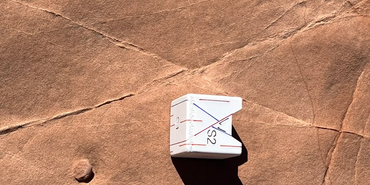Signed in as:
filler@godaddy.com
Signed in as:
filler@godaddy.com

These Andy Cubes can be used in the classroom, in the field, or simply as a display on your desk to remind you about the relationships between stresses and faulting/fracturing.

These Andy Cubes are inspired by Scottish geologist Ernest Masson Anderson, who in 1951 published “The Dynamics of Faulting and Dyke Formation with Applications to Britain” which became the classic paper describing what is commonly called “Andersonian Fault Theory”. Anderson’s theory classified faults based on the orientation and magnitude of the principle stresses. The principle stresses are defined by three magnitudes (S1, S2, & S3) and three orientations (SV, SHmax, & Shmin).
S1 = Maximum Stress S2 = Intermediate Stress S3 = Minimum Stress
SV = Vertical Stress SHmax = Maximum Horizontal Stress Shmin = Minimum Horizontal Stress
A general rule of thumb, is that the conjugate faults (red and blue lines) form at about 60° to each other, which is +/- 30° to S1. This rule remains for each type of fault regime as S1 becomes rotated from vertical to horizontal. The strike of the faults also remains parallel to S2, even as the cube becomes rotated, and perpendicular to S3. When the faults are “tiny” we refer to them as shear fractures, classified as Mode II fractures.
Mode I fractures are known as “opening mode” fractures (orange lines). These also strike parallel to S2 and open in the direction of S3 since it is the minimum amount of stress to overcome. Mode I fractures can go by many names including tension fractures, extension fractures, joints, and veins.
Stylolites are pressure dissolution features that form perpendicular to S1, however small teeth on a stylolite can form parallel to S1. These types of “fractures” are common in carbonate rocks but can also form in other types. These serrated surfaces develop as soluble minerals dissolve under high stress, which can then be deposited elsewhere leaving behind the geometry seen below and indicating the orientation of S1 during deformation.
By understanding the relationships between fracture orientations and stress, a geoscientists can begin to predict the stresses (or paleo-stresses) that created observable fracture patterns. Or, vice versa, if stresses are known, then geoscientists can predict the expected fracture patterns that would result. Try placing your Andy Cube on an outcrop and align it with the fracture patterns you observe, can you predict the stress field at which they developed?

Front







